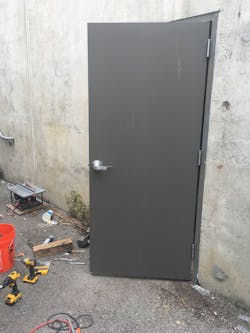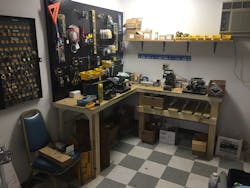Do you want to do something different every day? Want a challenge? Institutional locksmithing is just that and more. As the demand for security at institutions grows, the necessity for someone who knows every aspect of physical security grows as well. This is where the institutional locksmith comes in.
Many larger hospitals, colleges and school systems saw the need for this and created this position years ago. I’d venture to say it’s a rewarding career path. It can provide steady work, a regular paycheck and potential avenues to future growth. If you want to get into this business, here are some useful things you should know.
Getting Started
Getting your foot in the door might be the biggest obstacle you’ll face. Most institutions want experience, so, how do you go about getting this? For one, don’t rely on your ability to rekey a lock or duplicate a key. Most maintenance technicians can do both of these tasks. Key-making and rekeying make up only about 5% of institutional locksmithing. Masterkeying would be 10–20%, and masterkeying several different systems would be closer to 25%. The other 75% is related to working with hardware or low-voltage equipment.
As a school system carpenter, I already had been working on doors and locks before I got the position of locksmith. All I had to learn was keying, key-making and masterkeying, so I found an online school approved by my school system and dove right in.
Of course, this is subject to where you’re located. I cut my teeth in a fairly large school system, so doors, closers, exit hardware, access control and keying small-format interchangeable cores (IC) were the bulk of my work orders. The best way to get started, though, is to work under someone who knows a lot about doors and locks. I spent two years as a helper, before I got my chance to be a full-time locksmith.
Also, take advantage of any and all online and in-person manufacturer classes. I spent countless hours in the classroom learning the newest mortise lock, exit device or electric strike any manufacturer sales rep had to offer. I still do today, 25 years later. Take notes, lots of notes.
Most smaller, more-rural maintenance departments might not provide these learning opportunities, so you might have to go elsewhere. I left one large school system for another in a neighboring county not only for the actual position and money, but also for the opportunity to learn different keying systems. This paid off in the end, because I learned different hardware as well.
Be Willing to Learn
Even after 25 years in this industry as a locksmith, as well as a door and hardware sales rep, I always run across something new. So, the ability to research is absolutely necessary.
I covered a few of the general areas of knowledge you’ll want to know as an institutional locksmith, but more specifically, you’ll want to know more about the following: architectural hardware installation, hardware repair, storefront door hardware, wood door repair and keying systems. IC cores, panic devices, mortise case locks and cylindrical levers will be the bulk of what you’ll be keying, installing and repairing on a daily basis. SARGENT, Von Duprin, BEST, Schlage, LCN and Yale are the more common brands, but you might see aftermarket brands as well.
This might seem like an awful lot, but your mechanical ability will help you along the way. You’ll install and repair new hardware and learn how to assess each situation as it comes along.
Educational Resources
I used to use technical manuals as well as manufacturers’ literature, but now I mostly use online resources. You can find most of your manufacturer’s tutorials on the internet, as well as codes and other useful tips. Some guys might consider this to be cheating, but anything you can use to get that lock, door or hardware operational in the least intrusive manner is best.
Online courses also are an excellent way to advance your knowledge. NFPA.org (National Fire Protection Association), DHI (Door and Hardware Institute), ALOA (Associated Locksmiths of America) and ILA (Institutional Locksmith Association) provide a variety of training courses. Online professional networks, such as LinkedIn, can be useful tools as well. I use all of these resources.
Tools You’ll Want
Other useful tools for an institutional locksmith include an assortment of files, hole saws, a hammer drill, a reciprocating saw and a standard drill. A LAB Wedge pinning kit as well as factory pinning kits for specific ICs and a wide variety of followers, tweezers, small screwdrivers and a pinning tray are all part of what you’ll want to have at your disposal. Various jigs, picks, shims and setting blocks are other locksmith tools you’ll want as well. All of these can be ordered through locksmith suppliers.
Door Work
Some institutional locksmiths don’t work on doors, but for those who do, it’s vital to know the basics. Metal doors, glass or storefront doors, laminated and solid wood doors make up the bulk of what you’ll work on, with most being UL fire-rated doors. You definitely will want to familiarize yourself with NFPA 80 (National Fire Protection Association standards for Fire Doors and Openings).
You also will want to know how to measure a door properly (width first, then height, top hinge, center hinge and bottom, as well as centerline) and know the prep type used for ordering, as well what the standard glass sizes are. Knowing how to do the actual prep work for glass kits and hardware is vital as well.
When it comes to installing new hardware, I always use factory templates. Most hardware manufacturers supply templates in the box. Metal doors are best supplied already prepped. Fire doors have to be prepped at the factory or by an authorized UL-rated shop. Each state and county is different on labels, but most follow NFPA 80 and UL standards. Just a tip: Doors are best prepped in a shop laid flat, which ensures you figure in the stop.
On the Job
Time management is your biggest challenge as an institutional locksmith. When I worked for a university or K-12 school system, I always had 20 work orders one day and a handful the next. I was either crazy busy, or things were slow — there was no in between. So, I had to learn to use my time wisely. Of course, everyone is different, but I prioritize my work orders as follows:
- Emergency exit doors and exit hardware not working
- Keys lost or broken into the lock
- Doors or hardware broken or falling off
- Credentials not working
- Closers leaking or broken
- Everything else
When I was the only locksmith for one school system, I would knock out a few smaller work orders, mostly extra keys, for a single school at once while I was in that area. I kept all of my masterkeys and submasters in a key file, with all of the master bitting list in a key-management system. I always kept a few spare keys (and combinated ICs) ready for key changes. You absolutely must be organized, or this job will get the best of you.
In the Trenches
Every tradesman has certain tricks they use, and institutional locksmiths are no different. I learned early on to use a few tricks to get things done efficiently. The goal was to make sure the door and lock were operational afterward. As long as they were, I could go about my business.
One of my main tricks was manipulating a hinge. I use my hinge tweaker, but other hinge manipulators work as well. These simply go over the hinge pin, and by opening the door a little, you bend the knuckles and bring the two halves of a butt hinge closer together.
I don’t recommend this trick on fire doors that have to be placed back into compliance. You might have to replace hinges or shim the hinge in that case.
The other trick is the use of hook-and-loop strips. I use these for exit devices that I had to order a new dogging mechanism for as well as to hold a lock onto a door while I run screws into the door.
I also keep an assortment of screws in a parts organizer for just about every application. These are just a few of the things I do to make things go smoother and more efficiently. I could do an article just on tricks of the trade.
Great Job
If you decide to get into institutional locksmithing, I honestly can say there will be days when you might get frustrated and it might seem to be a thankless job. In fact, the only time you might hear anything is when you don’t get that door or lock repaired quickly enough.
Nevertheless, it’s a great job, because you’ll use your mechanical abilities to get the job done. You’ll basically be paid to be a tinkerer.
Tony Kasper has been an institutional locksmith for 25 years, working for several school systems and hospitals in Tennessee. He owns and operates Athens Door and Lock in Athens, Tennessee.
About the Author
Tony Kasper
Tony Kasper has been an institutional locksmith for 25 years, working for several school systems and hospitals in Tennessee. He owns and operates Athens Door and Lock in Athens, Tennessee.


